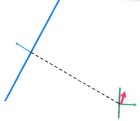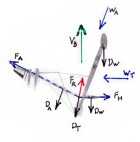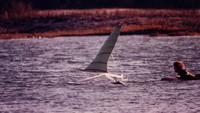High-Speed Sailing
| Vessel Name: | Sailien |
| Vessel Make/Model: | Experimental/custom |
28 September 2013
The America’s Cup
I watched, with interest, the videos of the 34th America’s Cup. At last we have fast sailboats engaged in a competition that is fun to watch. The virtual images (such as course boundaries, distance grid lines, separation between boats, etc.) overlaid on the real images really helps to keep the race [...]
31 August 2013
100 Knots for Hydroptere?
The latest news from Hydroptere is that they have plans for a 100 knot sailboat. This was posted on 26 Aug 2013, so look for that date at this address. http://hydroptere.com/en/the-news/last-news/
17 November 2012
Aptly named Sailrocket, blasts off!
While yet to be ratified, Sailrocket posted an average speed over 500 meters of 59 knots. I will not be surprised if they increase their record into the 60 knot range during this record attempt.
02 January 2012
More drag for VSR2?
I want to start by pointing out that the whole VSR2 team has done a stellar job and has demonstrated conclusively that the forces that drive a sailboat can be aligned for roll stability without using ballast and without using any down-force. (Trifoiler achieved roll stability by using down-force, but [...]
18 December 2011
My analysis of Sailrocket
I copied a diagram of VSR2 (wing doesn’t show well) and added in the major force arrows that apply. Be aware that these arrows are not correct in terms of scale (length) and some of their locations are guesses, however I believe I’m correct enough for us to learn something about what VSR2 has been [...]
23 October 2011
60 is within reach, what’s next?
I have been watching Sailrocket’s progress with great interest and there’s no question they have a winner. I fully expect to see them reach 60kt in the near future. Sailrocket has now demonstrated what I first learned with my models and again with my full-sized prototypes, that if you get the forces [...]
Eliminate the problem
Hydroptere is pushing the "limits" of established sailboat configuration by adding hydrofoils to a multihull. I'll agree that this is a sensible approach (as opposed to a totally new configuration) because if you change too many things at once, you can wind up with an unworkable craft and not know what's wrong. However, the last thing that Hydroptere did was flip in a strong gust.
If I had just flipped my craft (yep I've done that) the first thing I would do is study the situation so I could understand exactly why the craft flipped. I am certain that the engineers for Hydroptere have done just that and know exactly how much force, applied at what locations, caused the flip. I am also certain that they have taken steps to reduce the risk of a flip under similar conditions and the current craft is being fitted with improved hydrofoils. This is correct for the existing craft, but not (in my opinion) for the future craft.
At this point I take a different approach than most. Most people work at solving the problem and I used to think that was what I was doing as well. I have now come to understand that I look at a problem a bit differently than most; I'm not trying to solve the problem, rather I'm trying to totally understand it and, if possible, eliminate it. I don't like to make the same mistake twice, so if flipping the craft is a "mistake", I try to eliminate the cause of the flip.
Hydroptere is using the centuries old solution of adding balancing weight (crew and water ballast) but I suggest that with their resources, they should consider a new (and proven) approach. Bringing the major forces into alignment eliminates the problem of the wind flipping the craft, as I've discussed previously.
Bob
About & Links
- Bob's Surfing Blog
- Bob's Website
- Greenbird (Windjet)
- l'Hydroptere
- Le Projet Dared
- Macquarie Speed Sailing Team
- Monofoil Sailing
- Mountain Goat STOL
- Mr Smith's Amazing Sailboats
- Patent Office (Search)
- Radboat
- Sailien Prototypes (early), Delta, etc.
- Sailien Video
- Sailien Website
- The Basics of Surfboard Design
- The Basics of Surfboard Design en Espanol
- The Swedish Speed-Sailing Challenge
- Trifoiler
- Vestas Sailrocket
- Windjet Project
- WSSRC


